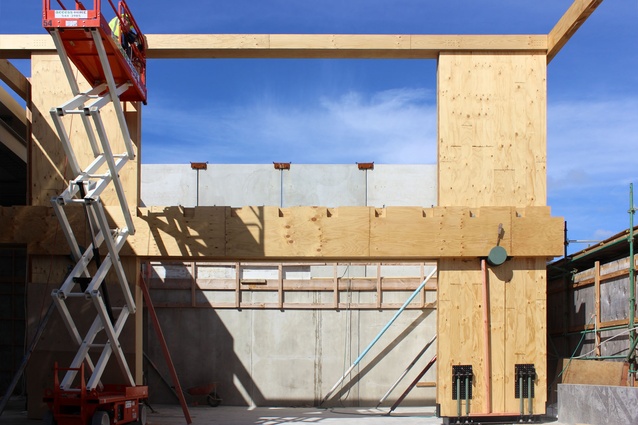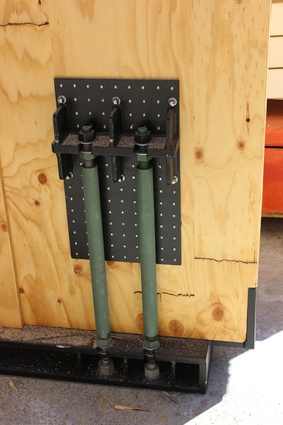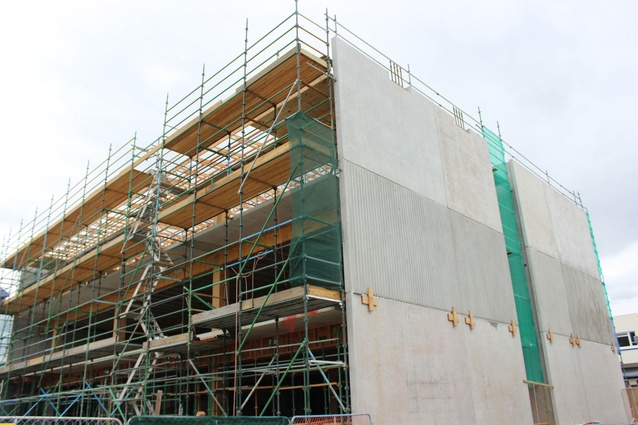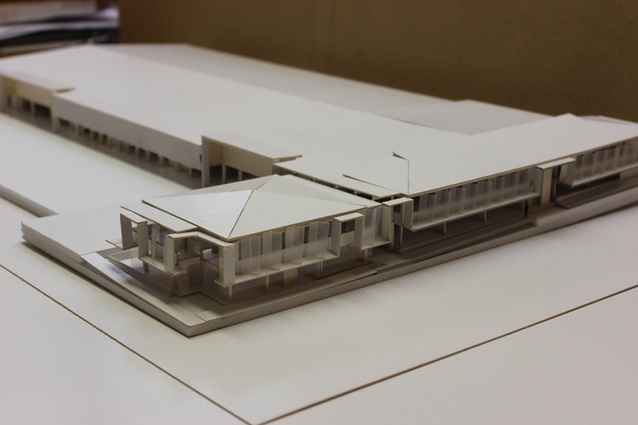Next generation
The Nelson region is known for its creative community, outdoor pursuits and vineyards, but of late, it is starting to carve out a distinct new architectural style as well, rooted in cutting-edge structural timber technology.
At the moment, the central suburb of Richmond is the epicentre for timber construction. Currently underway is a $2.2 million two-storey, 1200m2 retail and office building that will act as a bookend for a two large steel structures on Upper Queen Street.
Andrew Irving of Irving Smith Jack Architects (ISJ) informally refers to this building as ‘Generation III’, indicative of its design, which was developed following on from the first commercial timber building ISJ designed, the Nelson Marlborough Institute of Technology arts and media building.
Now, with considerable additional knowledge behind Irving and the design team, this building represents a further interpretation of what is possible in timber construction.
“NMIT represented a first for the New Zealand construction industry with an innovatively simple three-storey timber structural seismic system utlising research and testing from the University of Canterbury,” Irving says.
“Following completion of NMIT, ISJ collaborated with the University of Canterbury and Aurecon to complete a comparative study of structural performance, energy use and construction costs, comparing NMIT’s timber structural system with more traditional steel and concrete approaches.
“If NMIT is considered first generation, then our subsequent projects represent the next generations in the refinement and development of timber structural architecture in New Zealand, each developing the notion of damage avoidance design to safeguard against the risk of damage during a seismic event and allow rapid reoccupation.”
The NMIT building incorporates post-tensioned cables and U-shaped energy dissipators between the walls, which absorb seismic energy. All beams, columns and floors were constructed with engineered timber, using LVL components.
The structural elements of the building are all exposed, lending the building itself for use as a teaching facility, a theme that has remained consistent in the following generations of timber buildings.
The next building ISJ designed, ‘Gen II’, was Lucas House in Nelson, a three-storey 1500m2 commercial building. Lucas House is a timber/concrete hybrid structure utilising LVL columns and beams with post-tensioned rocking concrete shear walls.
Now, as construction of ‘Gen III’ is nearly complete, Irving says the knowledge gained from past projects meant aspects of this build could be significantly streamlined.
“In this building we found we didn’t need to use post tensioning, and we came up with a way we could just use dissipator units instead, providing the same amount of seismic protection. This meant we were able to simplify the detailing further.”
The laminated veneer lumber (LVL) post and beam structure sits on shallow foundations. It incorporates interspan flooring – in which 200mm x 200mm pre-stressed concrete beams are interspersed with timber. A layer of concrete is then poured on top to complete the structural flooring.
Prior to this building, detailing on LVL posts and beams had to be completed by hand. But the beams in this building are unique – they were the first to be manufactured by a new CNC machine at Nelson Pine, the Hundegger K2i, which notched the required holes in the sides of the timber beams that the pre-stressed flooring ribs slot in to.
“The timber industry is gearing up a lot,” Irving says. “Rather than all of the LVL components being hand made, we have some mechanisity [sic] about it. The CNC machine opens up opportunities to create much more elegant detailing.”
The shear walls are also timber, and are constructed with cross laminated timber (CLT). LVL was inserted at points in the walls where additional strength was needed.
Gibbons Construction general manager Shane Trench says for his team, getting away from the mindset that buildings are constructed with steel and concrete was the first challenge. “It is somewhat unchartered territory using timber in this way. We had previous experience working with it on the NMIT building, and then on the Halifax Street office building, designed by ISJ,” Trench says.
Gibbons, as the developer as well as the builder, made the initial decision to utilise timber. “People can look into this building and see the timber carcass – the LVL is all on show. You can see the guts of the building. We specifically exposed elements of the building because we wanted to showcase the timber as well as the damage avoidance design … there is a warmth about timber too. People like to touch it – it’s a tangible sort of material.”
But while the majority of this building is timber, there is still a place for concrete and steel. “Steel is a key component,” Irving says. “All the connections are steel, including the pivots, the plates that connect the beams to posts, and all the dissipators.”
Steel plates are fixed to the walls using European rectangular nails, or timber rivets, providing a very strong bond, equivalent in strength to welding the plate to the LVL. Rather than bolting the beams to columns, timber rivets were used here also, which meant contractors didn’t have to match bolts to holes.
Along with the yielding dissipators, seismic design included beams that can pivot on barrel connections.
CDT Consultants director, engineer Craig Thelin, says the steel plates were incorporated to strengthen the connections between the timber beams and columns. “The beams are sitting on the end grain of the columns. There was not enough bearing strength in the side grain of the beam so we recessed in a steel plate that supports the load over a bigger area,” Thelin says.
“Steel pivots were also incorporated on the gravity structure – attaching the LVL beams to the shear walls. The pivots are basically 300mm hollow steel sections that take the gravity loads and also transfer the lateral (earthquake) loads to the shear walls.
“The dissipators are steel rods externally mounted to the shear walls with steel brackets and fixed to the walls with timber rivets. They are also fixed to the foundation using cast-in hold-down bolts. The dissipator rod is inside a steel tube, which is filled with grout to prevent the rod from buckling. In an earthquake, the rod will stretch, or yield, dissipating the seismic energy.”
Thelin says the basis of this building’s design was developed from the Post-tensioned Timber Building Design Guide, which was authored primarily by University of Canterbury researchers.
“This technology was developed with post tensioning in mind, with the idea that by using post tensioning, when an earthquake stops, the post tensioning helps the building to self-right. But because of this building’s loads we decided post tensioning was not necessary.
“What we found is that without post tensioning you can still ensure a building returns to vertical by replacing the dissipators. One may stretch more than another in an earthquake [causing the building to move slightly] but when the dissipators are unscrewed and replaced, the building will naturally return to vertical,” Thelin says.
“The aim of this technology is damage avoidance. While you can expect some damage to interior partition walls in a seismic event – they are likely to crack - the elements that will incur damage are non-structural, and easily replaced or fixed.”
And as Gen III nears completion, Gen IV is well on its way to getting out of the ground just up the road. A freestanding $1.5 million two-storey 800m2 retail and office building, it develops the simplified design approach further and incorporates a prefabricated hybrid timber/concrete post tensioned floor system developed by the University of Canterbury known as 3PT.
“We are trying to pick up the things we have learnt with Gen III and come up with simpler ways to do things. We like the notion that you can use industrial or factory-made materials, sometimes in an unexpected way, to add to the quality of designs,” Irving says. “In this case, we enjoy working with exposed timber because we like the idea of expressing how the building works and we think it adds a richness to the materiality of the building.”


















